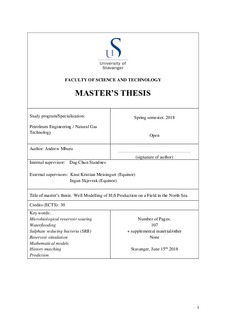| dc.contributor.advisor | Standnes, Dag Chun | |
| dc.contributor.advisor | Meisingset, Knut Kristian | |
| dc.contributor.advisor | Skjevrak, Ingun | |
| dc.contributor.author | Mburu, Andrew | |
| dc.date.accessioned | 2018-10-24T11:33:38Z | |
| dc.date.available | 2018-10-24T11:33:38Z | |
| dc.date.issued | 2018-06 | |
| dc.identifier.uri | http://hdl.handle.net/11250/2569323 | |
| dc.description | Master's thesis in Petroleum Engineering | nb_NO |
| dc.description.abstract | Hydrogen sulphide production can prove to be a very costly affair for exploration and production companies. Failure to implement efficient H2S control and mediation strategies can lead to a decrease in production assets, increase in operational costs and lost production as a result of shut-in wells. Developing a model to predict H2S production can therefore be very useful.
The aim of this thesis was to develop a model that could be used to predict the amount of H2S produced in seawater on a wellbore basis. A synthetic reservoir model was created using ECLIPSE100 simulator tracer tracking option to obtain a cumulative H2S production profile by plotting cumulative H2S against cumulative produced seawater. The results from this 2D homogenous reservoir model were used to form a basis upon which the mathematical models could be tested.
Two models were tested, a piecewise linear model and an exponential model. Having tested the mathematical expressions and optimized the parameters, the models were then applied to wellbore plots of H2S data from a souring field on the North Sea. The historical cumulative production data from the field was plotted in order to observe the production profiles of the different wellbores. Of the three distinct profiles that were observed, only two were used for analysis in this thesis, type 1 and type 2. The models were then compared based on how well they fit the historical data of two types of curves. Finally, the prediction of H2S production rate in g/m3 of produced seawater for each of the models is presented.
Based on the model fit to the historical data and the assumption that conditions in the reservoir will remain constant during the period of prediction then the models developed in this work allow a fairly reasonable prediction of the rate of H2S production. These predictions can be very useful for planning H2S control strategies and production management of producing wells and new infill wellbores. | |
| dc.language.iso | eng | nb_NO |
| dc.publisher | University of Stavanger, Norway | nb_NO |
| dc.relation.ispartofseries | Masteroppgave/UIS-TN-IEP/2018; | |
| dc.subject | petroleum technology | nb_NO |
| dc.subject | petroleumsteknologi | nb_NO |
| dc.subject | petroleum engineering | nb_NO |
| dc.subject | reservoarteknologi | nb_NO |
| dc.subject | reservoir engineering | nb_NO |
| dc.subject | production technology | nb_NO |
| dc.title | Well Modelling of H2S Production on a Field in the North Sea | nb_NO |
| dc.type | Master thesis | nb_NO |
| dc.subject.nsi | VDP::Teknologi: 500::Berg‑ og petroleumsfag: 510::Petroleumsteknologi: 512 | nb_NO |
